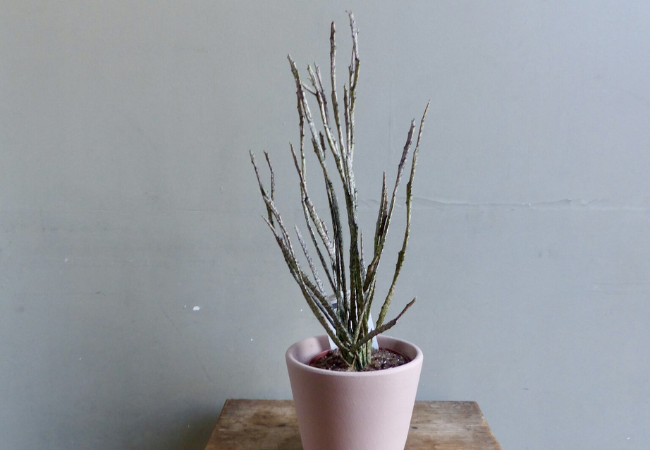In the spotlight: Euphorbia platyclada
- Posted on
- By Robin
- Posted in euphorbia platyclada, in the spotlight

You may have spotted the posts we drop on our Instagram under the captivating title of “Plant in the spotlights”. We’ve decided that, although most of those posts are already very interesting, we wanted to add a more elaborate blogpost to every special plant. This is the first one of the upcoming series! At GRUUN we want you to learn everything you can about plants and we’re happy to help.
So, the Euphorbia platyclada. Have you seen this weird looking plant on our store or webshop already? It’s often referred to as “Dragon Bones”. You must have already seen it in this Instagram post.
This Euphorbia is definitely one of Robin’s favourite plants he has at home. It has everything a plant collector could want. A unique appearance and it’s very easy to take care of.

It’s a member of the Euphorbiaceae family and the botanical meaning of “platyclada” is “broad stem”. It’s also known as the “dead stick plant” for obvious reasons. This very cool succulent is native to south/south-west Madagascar, where it grows under pretty harsh conditions in the dry forest. This particular habitat is known for their variety of unusual and endemic plants. Some other notable examples are Baobab trees and Pachypodium. In the wild they usually grow in flat mats. But as there is some variation in the species, some grow vertically like the ones we sell in store. Its appearance helps the plant to hide from predators. Dead plants don’t look like the tastiest snack to them. Unfortunately that doesn't help against humans because it is on the IUCN Red List of Threatened Species due to habitat degradation.
The plants get these miniscule flowers at the top that develop into tiny seed pods. The color can vary from yellow to orange to brown. (P.S. edit: mine has some now! Scroll down to see some homemade pictures)

- Care
It is not a difficult plant to keep happy.

They do need a lot of light and even a couple hours of direct sun. Under full sun, the plant will get a more pinkish tint. Under lower light it’s more brownish. Also be careful to not put it in too harsh sunlight, as it might get burned. They come from a warm place so avoid cold drafts etc. and any temperatures below 10°C, but it is recommended to keep this plant at minimum 18°C all year round. As this plant doesn’t like too high humidity levels, it’s crucial to keep it in a dry spot, to prevent any fungus problems.

Coming from the dry forest, it is not used to staying wet for a long time, so it needs a very well draining cactus-succulent soil mix. You have to let the soil dry out completely in between watering. But don’t keep them bone dry for weeks or months like you could do with a cactus, as this will completely dry it out and make it very unhappy
Fertilise once a month during the growing season. Avoid fertilizing in fall and winter when the plant is dormant.

Propagation is a bit tricky. The seeds - if you’re already able to find them - are difficult to germinate. Cuttings are an option but you have to be careful when you cut Euphorbias because of the milky white sap that can irritate your skin and eyes. Please wear gloves! This counts for pruning as well, if your Euphorbia has some ugly or dying parts, you can cut these off but be careful. When you take a cutting, let it callous over for a couple days before you plant it. Water once after planting and let the soil dry out completely before you water again. Pick a small pot to plant it or it will stay moist for too long.

